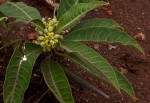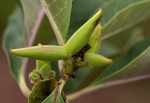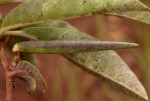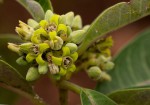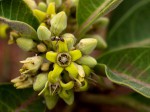Raphionacme utilis
Selected images: Click on each image to see a larger version and details of the record View all images (5)
Detailed records: Display species records QDS maps by: Google Maps Point records by Google Maps
Species details: Click on each item to see an explanation of that item (Note: opens a new window)
| Synonyms: | |
| Common names: | |
| Frequency: | |
| Status: | Apparently introduced |
| Description: |
Erect perennial herb, up to 10 cm high, growing from a broadly sub-spherical to spindle-shaped tuber, 50-150 cm in diameter. Stems, 1-few, 80 cm long, erect, brownish. Leaves rosette-like, spreading, subsessile to petiolate, ovate-elliptic or obovate, up to 8.5 × 4 cm long, dark green above, hairless or pubescent, purplish below; margin wavy; petiole 0-10 mm long. Flowers mostly only terminal, more or less open inflorescence. Corolla lobes oblong-ovate, 6 × 2 mm, green to green-violet. Corona whitish, hairless or papillose; lobes 3-segmented; central segment 5-6 mm long, linear-filiform; lateral segments fused to form a coronal annulus. Fruit in horizontally spreading, paired follicles or single, narrowly ovoid, 40 × 8 mm. |
| Type location: |
Angola |
| Notes: | |
| Derivation of specific name: | utilis: useful |
| Habitat: | |
| Altitude range: (metres) | |
| Flowering time: | |
| Worldwide distribution: | Angola, Cameroon, DRC and Zimbabwe. Apparently introduced in Mozambique. |
| FZ divisions: | MS |
| Growth form(s): | |
| Endemic status: | |
| Red data list status: | |
| Insects associated with this species: | |
| Spot characters: | Display spot characters for this species |
| Literature: |
Goyder, D.J., Gilbert, M.G. & Venter, H.J.T. (2020). Apocynaceae (Part 2) Flora Zambesiaca 7(2) Pages 36 - 37. Venter, H.J.T. (2009). A Taxonomic revision of Raphionacme (Apocynaceae: Periplocoideae) South African Journal of Botany 75(2) Pages 338 - 340. (Includes a picture). |
Other sources of information about Raphionacme utilis:
Our websites:
Flora of Zimbabwe: Raphionacme utilisExternal websites:
African Plants: A Photo Guide (Senckenberg): Raphionacme utilisAfrican Plant Database: Raphionacme utilis
BHL (Biodiversity Heritage Library): Raphionacme utilis
EOL (Encyclopedia of Life): Raphionacme utilis
GBIF (Global Biodiversity Information Facility): Raphionacme utilis
Google: Web - Images - Scholar
iNaturalist: Raphionacme utilis
IPNI (International Plant Names Index): Raphionacme utilis
JSTOR Plant Science: Raphionacme utilis
Mansfeld World Database of Agricultural and Horticultural Crops: Raphionacme utilis
Plants of the World Online: Raphionacme utilis
Tropicos: Raphionacme utilis
Wikipedia: Raphionacme utilis
